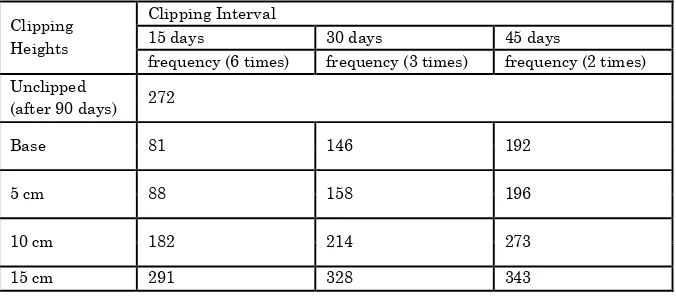ISSN 2286-4822 www.euacademic.org
Impact Factor: 3.1 (UIF) DRJI Value: 5.9 (B+)
Impact of Clipping treatments on the biomass of
Cenchrus ciliaris. L
RAJKUMARI PARWANI Government Science College, Gandhinagar Gujarat, India
Abstract:
Key words: Buffel grass, Cenchrus ciliaris , Clipping, Above Ground Biomass(AGB), Below Ground Biomass (BGB).
Introduction
Grasslands, including sown pasture and rangeland, are among the largest ecosystems in the world and contribute to the livelihoods of more than 800 million people. They are a source of goods and services such as food and forage, energy and wildlife habitat and prevent soil erosion. Buffel grass (Cenchrus
ciliaris Linn.), a perennial pasture grass species, has wider
adaptability in varied edaphic habitat. Perennial grasses are major components of tropical pastures, provide bulk of herbage to animals. Knowledge and appreciation of the morphology and growth habits of the species used and their responses to defoliation is very helpful in maintaining the desired proportion of grass and legumes in forage stand. In an actively growing plant, all of the energy captured from sunlight is not utilized in the production of new plant tissue, but part of it is used in respiration and part of it is stored mainly in basal portions of the plant so that new leaves can be produced after defoliation. Thus, knowledge of the effect of defoliation at different stages of growth and at different frequency is essential in foreseeing the possible effect of grazing or cutting practices (Singh and Mall, 1976). Clipping is desirable for increasing herbage yield as observed by Dabadghao and Das, 1963. Therefore, the present study was undertaken with a view to evaluate morphological characteristics and growth of Cenchrus ciliaris generally cultivated in an arid ecosystem in India.
Material and Method
Statistical analysis of the data was done to evaluate the significance of the treatments.
Results and Discussion
It was revealed that greater herbage was produced when the plants were clipped at the height of 15 cm and at an interval of 45 days, as compared to 10 cm, 5 cm, base heights, and 15-day and 30-day interval of clipping. Yield is supposed to be reflection of the clipping height.The basal meristems are likely to be injured in close clipping or grazing. Thus15 cm seems to be an optimium height for increased herbage production in
Cenchrus ciliaris. Frequency of herbage removal had
pronounced effect upon production of forage. Increasing the length of clipping interval resulted in significant increase in Yield Average production decreased with increased number of clipping. Clipping at 15- and 30-day intervals produced less herbage than clipping at 45-day interval. It may be concluded that biweekly and monthly clipping of the herbage reduced the amount of food materials available for translocation to the roots, so that the capacity to produce new tillers was reduced in
C.ciliaris. Data on quantity of belowground production under
likewise produced the greatest root yield. Plants in high vigour displayed a well-developed root system. It appears that any herbage removal reduces total root production. Clipping height also had a significant effect upon root growth. The closer clipping reduces the herbage yield and this in turn the belowground production.
The height of the plant was thus substantially reduced to clippingand number of tillers were reduced during frequent clipping intervals 15 and 30days. It may be argued that biweekly and monthly clipping of the herbage reduces the amount of food materials available for translocation to the roots which in turn lowers the capacity of Cenchrus ciliaris grass to produce new tillers.
Cutting forage plants at a stage of maturity or harvest interval range provide adequate food reserves and/or basal or auxiliary tillers or buds for regrowth and reproduction to occur without loss of plant vigor. Cutting forage plants at certain heights promotes the vigor and health. Cutting heights provides adequate residual leaf area, adequate numbers of terminal, basal or auxiliary tillers or buds, insulation from extreme heat or cold, and or unsevered stem bases that store food reserves needed for full, vigorous recovery.
TABLE 1 Height (cm/plant) under various clipping treatments for Cenchrus ciliaris
Clipping Heights
Clipping Interval
15 days 30 days 45 days
frequency (6 times) frequency (3 times) frequency (2 times) Unclipped
(after 90 days)
125
Base 64 82 110
5 cm 69 92 120
TABLE 2 Number of Tillers/plant under various clipping treatments for Cenchrus ciliaris
Clipping Heights
Clipping Interval
15 days 30 days 45 days
frequency (6 times) frequency (3 times) frequency (2 times) Unclipped
(after 90 days)
31
Base 14 21 30
5 cm 21 29 38
10 cm 24 32 42
15 cm 28 34 48
TABLE 3 Above ground herbage production (gm/plant) under various clipping treatments for Cenchrus ciliaris
Clipping Heights
Clipping Interval
15 days 30 days 45 days
frequency (6 times) frequency (3 times) frequency (2 times) Unclipped
(after 90 days) 272
Base 81 146 192
5 cm 88 158 196
10 cm 182 214 273
15 cm 291 328 343
TABLE 4 Below ground herbage production(gm/plant) under various clipping treatments for Cenchrus ciliaris
Clipping Heights
Clipping Interval
15 days 30 days 45 days
frequency (6 times) frequency (3 times) frequency (2 times) Unclipped
5 cm 69 92 156
10 cm 88 115 223
15 cm 94 124 251
Acknowledgement
Author is thankful to Dr.C.N. Pandey, Director, GEER Foundation,Gandhinagar for providing necessary facilities, Dr.Pragna Vadher, Principal, Government Science College,Gandhinagar for her valuable support , Dr. M.P. Rajora, Principal Scientist, Dr. Manjeet Singh, Principal Scientist and Dr. N.K. Dwivedi for their valuable guidance.
References
Dabadghao, P.M. and Das, R.B. 1960-63. Annual Reports, CAZRI, Jodhpur.
Singh, V.P and Mall, L.P. 1976. Responses of Andropogon
plumilus Roxb. to various heights and intervals of
